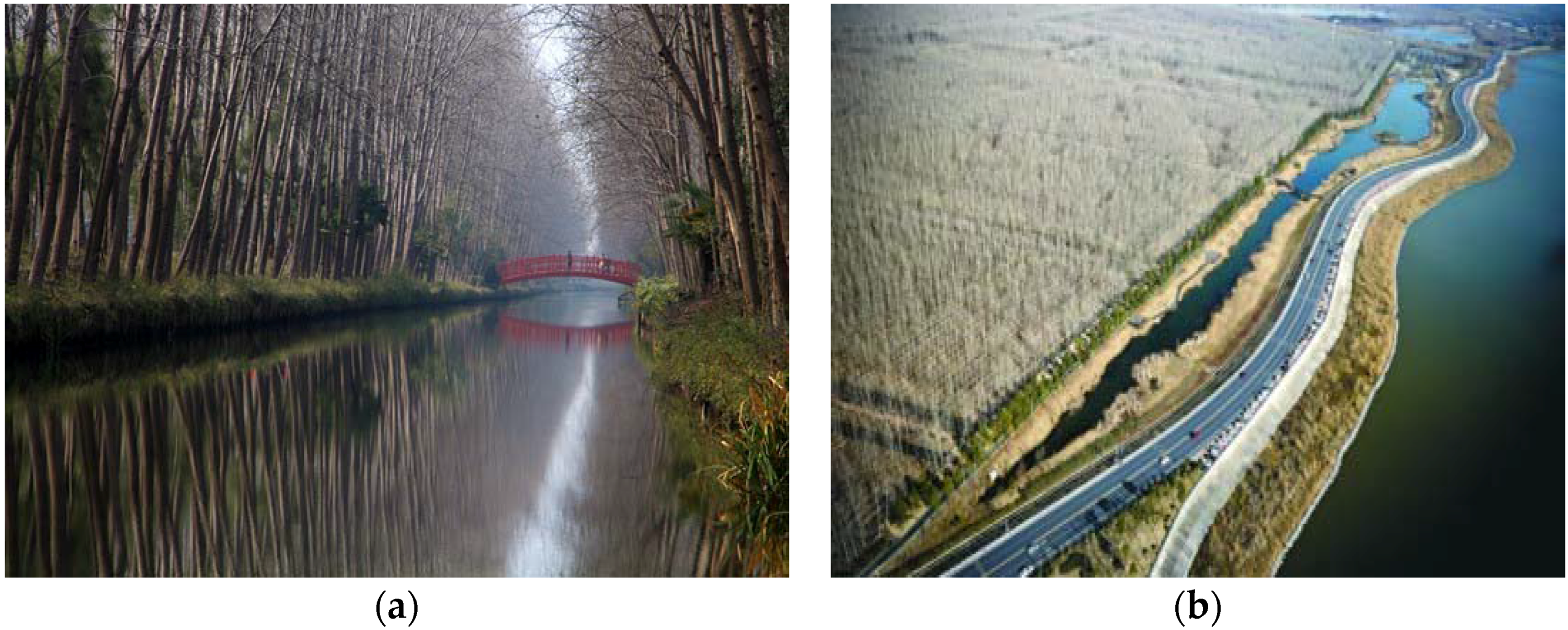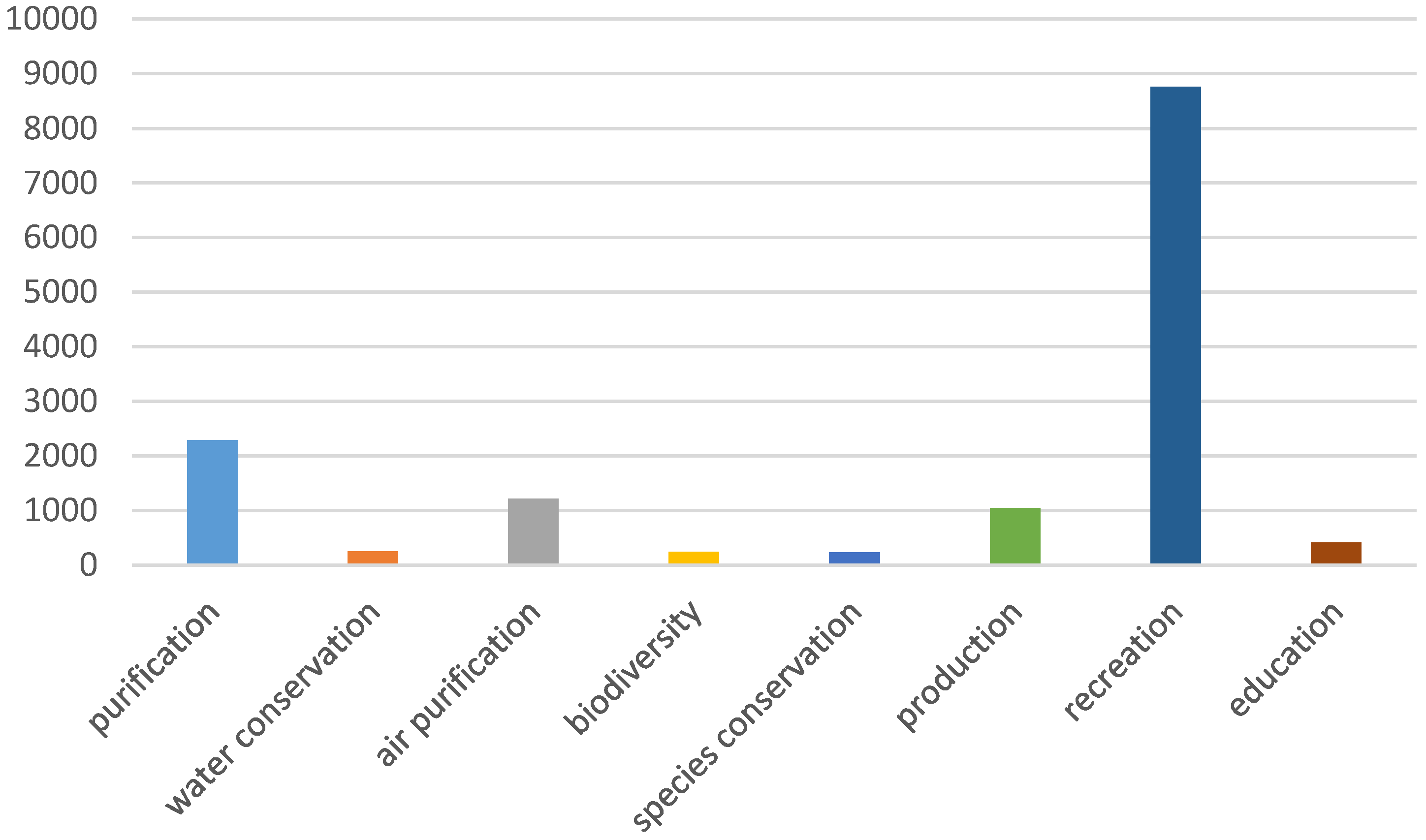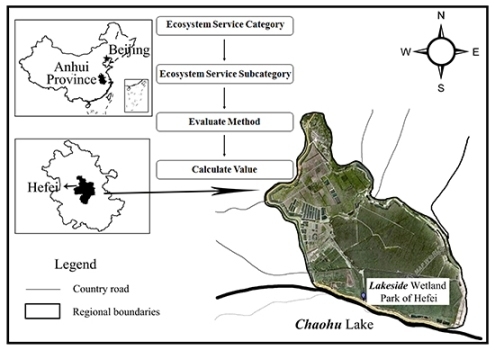3.1. Data Sources
The data in the current article are mainly from field surveys and the local statistical yearbook. In order to grasp the status of flora and fauna in the wetland, methods like route surveys and investigations based on observation points and sampling locations are used. An overall exploration was done in the park in 2015–2016. In addition, the monitoring data of water and atmospheric air quality are from the park and the park regional environmental quality monitoring report which was composed by the local environmental protection department of Hefei.
The data involved in this study are divided into two categories: background data and questionnaire data. The background data of this study are divided into two parts: current data and historical data. The current data are mainly from 2015 to 2016 sampling survey, which includes wetland water quality data, biological data (including phytoplankton, benthic animals, and fish) and plant data. We select 5 m × 5 m woody quadrant investigation in each sample, and within each woody sample select five 1 m × 1 m herb samples, including a total of 150 samples. The research content includes many kinds of woody plants (noting physical quantity), and herbaceous vegetation types (noting physical quantity, coverage, abundance, average height, etc.). To merge the field investigation results and the previous data, Global Positioning System (GPS) precise positioning is done to establish corresponding interpretation signs in ERDAS 8.6 (Intergraph Corporation, Huntsville, AL, USA) for man–machine interactive interpretation to edit and verify the wetland area data. Historical data is provided by various management departments such as the local forestry bureau and the Bureau of Wetland Nature Reserves. Vegetation identification and classification are based on “the ecological types of Anhui vegetation”, with “China’s wetland vegetation” as the standard.
Wetland resource status data included many aspects: the general situation of the wetland, situation of wetland resources, wetland management situation (including wetland area and wetland type), wetland evaporation, average temperature of wetland, wetland material output, wetland aquatic vegetation, wetland water conservation amount, wetland species number, higher floristic composition, zooplankton species quantity, species of benthic animal quantity, species quantity, birds species number, number of mammal species, wetland management agencies basic situation, protection of wetland resources input, wetland water quality index data, and wetland annual number of tourists.
The questionnaire data mainly includes a survey questionnaire to determine willingness to pay for the recreational value of the wetland. The questionnaire was conducted in the wetland park to understand the awareness degree of both the surrounding residents and tourists to the urban wetland. The main contents of the questionnaire are as follows: (1) investigate the awareness of wetlands including the degree of familiarity and protection awareness (e.g., willingness to pay, etc.); (2) investigate the basic situation of the survey respondents: education level, economic conditions, etc.
In this study, the data sources of recreation services valuation are based on the random sampling principle. Questionnaires were used in the field survey. A total of 280 questionnaires were handed out and 267 questionnaires (95.36%) were actually recovered. Among them, 254 questionnaires were valid, giving a 95.13% effective recovery rate of questionnaires.
3.3. Carbon Tax Method and Afforestation Cost Method
In this study, the carbon tax and afforestation cost method were used to estimate the service value of carbon sequestration and oxygen release by the wetland ecosystem. The carbon tax and afforestation cost method are the two most-used methods for the evaluation of these service values. For the carbon tax method, we get the quantity relationship of fixed CO
2 and O
2 release from the photosynthesis reaction equation, and then multiply by national or international standards on CO
2 emission charges, which converts material quantity to value amount thereby getting the value of fixed CO
2. The afforestation cost method refers to the construction cost of the forest that can absorb equal amounts of CO
2 to replace the value of other means to absorb CO
2 [
22]. Here we use the fixed CO
2 amounts sequestered by the ecosystem, multiplied by the average unit cost of afforestation and forest stock needed to sequester the same amount, and use that to estimate the value of fixed CO
2 of ecosystem. According to the photosynthesis equation
1.63 g CO2 is needed and 1.20 g O2 will be released by a plant to produce 1 g of dry matter, wherein the fixed pure amount of C is 0.44 g; that is, the content of C element accounts for about 45% of dry matter. Combining this result with the biomass of wetland plants, the fixed CO2 and O2 releases of wetland plants can be calculated separately.
Generally, the Swedish tax rate will be used in the carbon tax calculation and then converted to a tax rate for fixed CO
2. For the afforestation cost, the average reforestation cost of fir, pine, and paulownia will be used, and then converted into the cost of fixed CO
2 [
23]. In practice, when estimating the value of carbon sequestration and oxygen release, the estimation of carbon sequestration normally uses the average value of carbon taxes and afforestation costs. In this way, it is even closer to the real value and this method has been widely used [
24]. For the evaluation of oxygen release value, the average value of afforestation costs and industrial oxygen production costs are applied. The formula is as follows:
where
U2 represents the value of climate regulation functions, namely, fixed CO
2 and O
2 release value;
C represents carbon sequestration;
Pc is the average value of the international universal carbon tax rate and the cost of reforestation in China;
O is the amount of oxygen released; and
Po is the average price of afforestation and industrial oxygen production costs. We have
where
NPPi is the first productivity of
i type plant, and
Si is the area of
i species plant.
NPPi is calculated as follows:
NPP (net primary productivity) is an estimated result. The photosynthetic products fixed in plant photosynthesis are reduced by respiration-based consumption of the plants themselves, also known as primary productivity. The Chikugo model [
25] is the mechanism of calculating plant growth through considering adequate soil moisture and vegetation growth conditions, and calculating the net radiation and radiation dryness to get
NPP model. The formulas are as follows:
where
NPP is vegetation’s net primary productivity (tDM·hm
−2·a
−1),
RDI is radiation dryness,
L is the latent heat of evaporation in J·g
−1,
r is annual precipitation in cm·a
−l, and
Rn is the net amount of radiation obtained by the land surface (kcal·cm
−2·a
−1). Thereby, the value of the main carbon fixation and oxygen release plants in Lakeside Wetland Park on climate regulation can be calculated. The latent heat of evaporation has the following relation with temperature t:
3.4. Shadow Engineering Method
The shadow engineering method can be used to estimate the value of flood control and water storage. The gross storage capacity of Lakeside Wetland Park, as the usable storage, can be used to estimate the service value of flood regulation and water storage. To be specific, we use the building cost of projects required to store a corresponding volume as an estimate for the service value, based on the fact that 0.67 CNY [
26] is invested to build 1 m
3 of reservoir capacity in China at present. The water area of Lakeside Wetland Park is 262.6 hm
2. Reed fields, fishponds, canals, and rivers flowing through the park have water storage functions. The total amount of flood regulation and storage V in the wetland is the sum of the above items. When the shadow engineering method is used to estimate the value of flood regulation and water storage, the construction cost of building a reservoir with storage capacity equal to the water yield of this wetland park is the estimate. Then, the mathematical expression of the shadow engineering method that is used to estimate the value of flood regulation and water storage is as follows:
where
U3 is the value of flood control and water storage,
V represents the total wetland flood storage capacity, and
t represents unit cost of capacity. The specific
V calculation formula is:
where
V is the volume of water storage,
Ai is the area of wetland use of
i type, and
hi is the water storage balance in wetland type
i use.
3.5. Results Reference Method
Not only do wetlands have the service value of material production, flood regulation, and water storage as well as carbon fixation and oxygen release, but they also have the service values of purifying gas, biodiversity, species conservation, and cultural education. Since the Lakeside Wetland Park was only opened in 2014, the results reference method will be used on the evaluation of those above-mentioned service values. The results reference method is to use one or more evaluation methods to estimate the economic value of a similar environmental service function. This estimator will be amended and adjusted and then applied to the regional environment of interest [
27]. The basic steps of the results reference method are as follows. First, analyze previous research results to find and evaluate similar cases. Then, obtain the currency value of the environmental service function through basic economic methodology and calculate the value of unit time. Apply the result to the region to be estimated and acquire evaluation results. The cost of the results reference method is very low since it is convenient and efficient to find the research results for reference, analyze the data rationality, and reconstruct it if necessary. The accuracy of this method can be relatively increased if two similar evaluation objects can be found. Otherwise, the possible error can be relatively large. Shao [
28] employed this method to evaluate the value of biological habitats provided by the Yinchuan Lakeside Wetland ecosystems. Gi [
29] used this method to evaluate the cultural value and values for scientific research, as well as the value of pollutant degradation and biodiversity conservation, of the east Chongming marsh ecosystem.
Because Lakeside Wetland Park is located by the shore of Chaohu Lake with rich wetland resources providing the service of pollutant degradation, it helps to maintain a good ecological environment. However, Lakeside Wetland Park’s phase I and phase II opened only in 2012 and 2013, respectively, and its phase III has not been fully completed yet, so its processing capability for pollutants such as heavy metals, chemical oxygen demand (COD), and biochemical oxygen demand (BOD) is still unknown. Therefore, results using the reference method are used to evaluate the value of pollutant degradation and purification services of this wetland park.
where
U4 is the value function for pollutant degradation,
A is the area of wetland, and
W1 is the value of the purification service per unit area, using as reference the public value from Constanza [
30] (refer to
Table 3).
The results reference method is also used to calculate biodiversity value. According to results of an investigative report by Xie [
31], the unit value of wetland ecosystem biodiversity conservation is 2212.2 (hm
2·a). Substituting this into Formula (12), the biodiversity conservation value of Lakeside Wetland Park is
where
U5 is the value function for biodiversity,
A is the area of wetland, and
W2 is the value of the purification service of a unit area, with the reference value being the public value from Constanza [
30] (refer to
Table 3).
The results reference method is used to calculate species conservation value. Take Constanza’s research results into consideration (see
Table 3). The unit area value of species’ habitats function of wetland ecosystems is U$304/hm
2, equivalent to 1939.52 CNY/hm
2 (exchange rate of US$1 = 6.38 CNY), and Xie [
31] average 2344 CNY/hm
2 to China’s terrestrial wetland ecosystem assessment, which is 2089 CNY/hm
2, as per-unit area was used as the basis of species’ habitats functional value. Formula (13) calculates the total value of species’ habitats of Lakeside Wetland Park as:
where
U6 is the value function for species habitat,
A is the area of wetland, and
W3 is the value of the purification service of a unit area (reference value from Constanza [
30] in
Table 3).
The unique land and water interaction topography and abundant natural resources have given this lakeside wetland a considerably high scientific research and cultural value, which we calculate with Formula (14):
where
U7 is the value function for scientific research and cultural value,
A is the area of wetland, and
W4 is the value of the purification service of a unit area (reference value from Constanza [
30] in
Table 3).
3.6. Contingent Value Method (CVM)
In this study, we use the conditional value method to estimate the value of recreational services of this park. The CVM method uses questionnaires to put the non-market environmental resources or services on a virtual market. Estimated market information was provided by the questionnaires, through asking people about their maximum willingness to pay (WTP) through the improvement of environmental quality or minimum willingness to accept (WTA) through toleration of environmental losses. These data are used to work out the value of the environmental goods [
32]. To address the core issue of CVM valuation and according to previous research questionnaire results [
33], this study used a payment card questionnaire and asked respondents to select their WTP/WTA from a given set of values.
WTA or WTP applicability depends on whether the respondent has clear rights to the environmental goods. If the consumer has clear legal rights to the environmental goods, and you are asking him or her to give up these rights, WTA should be used; otherwise, WTP should be used. This paper follows the above viewpoints and WTP was used in this CVM research evaluation.
where
N is the annual number of tourists,
E (
WTP) is their willingness to pay per capita, and
TNUV is the recreational value.
In order to determine the effectiveness of the CVM method [
34], we need to check whether the relevance obtained from
WTP and individual socio-economic variables is consistent with the principles of economics. Logistic Regression is a widely used qualitative variables regression. This study is based on field research data, and we used the introduction of dummy variables to describe whether there is willingness to pay when these are used as dependent variables. By an independence test, this study can discover the dependency relationship with the dependent variable that is related to social characteristics and treat it as an argument to examine the validity of
WTP by carrying out logistic regression:
In the above formula, is the probability of willingness to pay, is observed dependence relationship between individual i and variable , is coefficient, and is an error term in .













